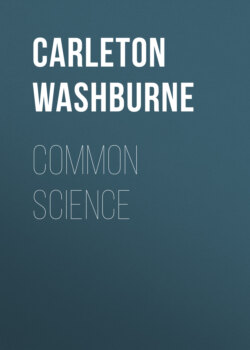Читать книгу Common Science - Carleton Washburne - Страница 15
На сайте Литреса книга снята с продажи.
Inference Exercise
ОглавлениеExplanatory Note. In the inference exercises in this book, there is a group of facts for you to explain. They can always be explained by one or more of the principles studied, like gravitation, water seeking its own level, or air pressure. If asked to explain why sucking through a straw makes soda water come up into your mouth, for instance, you should not merely say "air pressure," but should tell why you think it is air pressure that causes the liquid to rise through the straw. The answer should be something like this: "The soda water comes up into your mouth because the sucking takes the air pressure away from the top of the soda water that is in the straw. This leaves the air pressing down only on the surface of the soda water in the glass. Therefore, the air pressure pushes the soda water up into the straw and into your mouth where the pressure has been removed by sucking." Sometimes, when you have shown that you understand the principles very well, the teacher may let you take a short cut and just name the principle, but this will be done only after you have proved by a number of full answers that you thoroughly understand each principle named.
Some of the following facts are accounted for by air pressure; some by water seeking its own level; others by gravitation. See if you can tell which of the three principles explains each fact:
1. Rain falls from the clouds.
2. After rain has soaked into the sides of mountains it runs underground and rises, at lower levels, in springs.
3. When there are no springs near, people raise the water from underground with suction pumps.
4. As fast as the water is pumped away from around the bottom of a pump, more water flows in to replace it.
5. After you pump water up, it flows down into your pail from the spout of the pump.
6. You can drink lemonade through a straw.
7. If a lemon seed sticks to the bottom of your straw, the straw flattens out when you suck.
8. When you pull your straw out to remove the seed, there is no hole left in the lemonade; it closes right in after the straw.
9. If you drop the seed, it falls to the floor.
10. If you tip the glass to drink the lemonade, the surface of the lemonade does not tip with the glass, but remains horizontal.
Section 4. Sinking and floating: Displacement.
What keeps a balloon up?
What makes an iceberg float?
Why does cork float on the water and why do heavier substances sink?
If iron sinks, why do iron ships not sink?
Again let us imagine ourselves up in the place where gravitation has no effect. Suppose we lay a nail on the surface of a bowl of water. It stays there and does not sink. This does not seem at all surprising, of course, since the nail no longer has weight. But when we put a cork in the midst of the water, it stays there instead of floating to the surface. This seems peculiar, because the less a thing weighs the more easily it floats. So when the cork weighs nothing at all, it seems that it should float better than ever. Of course there is some difficulty in deciding whether it ought to float toward the part of the water nearest the floor or toward the part nearest the ceiling, since there is no up or down; but one would think that it ought somehow to get to the outside of the water and not stay exactly in the middle. If put on the outside, however, it stays there as well.
A toy balloon, in the same way, will not go toward either the ceiling or the floor, but just stays where it is put, no matter how light a gas it is filled with.
The explanation is as follows: For an object to float on the water or in the air, the water or air must be heavier than the object. It is the water or air being pulled under the object by gravity, that pushes it up. Therefore, if the air and water themselves weighed nothing, of course they would be no heavier than the balloon or the cork; the air or water would then not be pulled in under the balloon or cork by gravity, and so would not push them up, or aside.
